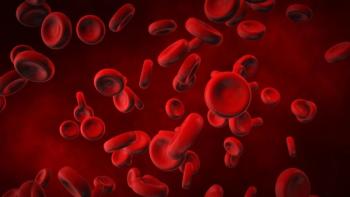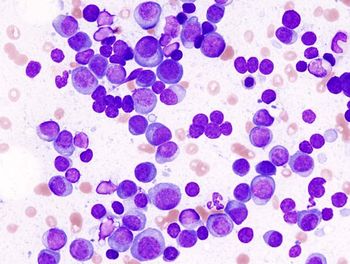
DLL3-Targeted ADC Produces Responses in Previously Treated ES-SCLC
Promising phase 1 data appear to support further evaluation of ZL-1310 as a treatment for patients with extensive-stage small cell lung cancer.
Treatment with ZL-1310, an investigational DLL3-targeting antibody-drug conjugate (ADC), yielded responses among a small cohort of patients with previously treated extensive-stage small cell lung cancer (ES-SCLC), according to a press release on findings from a phase 1a/1b study (NCT06179069).1
Data presented at the EORTC-NCI-AACR (ENA) Symposium 2024 showed an objective response rate (ORR) of 74% (95% CI, 48.8%-90.9%) among 19 evaluable patients, with anti-tumor activity occurring across all dose levels. Investigators reported responses in patients with DLL3 H-scores ranging from 5 to 260; no responses occurred in tumors that lacked DLL3 expression.
After a median follow-up of 2.4 months, the median duration of response (DOR) was not estimable at the time of analysis. Among 14 patients with a response, 13 are still receiving study treatment, with 1 patient having ongoing treatment at more than 6.5 months.
Regarding the 6 evaluable patients with brain metastases at baseline, all had a partial response (PR) following treatment with ZL-1310. Investigators noted a PR at the time of first tumor assessment for a patient with disease progression on prior DLL3-targeted bispecific therapy.
Among 25 evaluable patients in the safety population, ZL-1310 was generally well-tolerated at all dose levels, and most treatment-emergent adverse effects (TEAEs) were grade 1/2. Investigators reported 1 dose-limiting toxicity—grade 4 transient neutropenia or thrombocytopenia—at the 2.4 mg/kg dose.
Overall, 20% (n = 5/25) of patients had grade 3 or higher treatment-related AEs (TRAEs), with the most common being neutropenia (12%: n = 3/25). Serious TRAEs and dose reductions occurred in 8% (n = 2/25) and 12% (n = 3/25) of patients, respectively. There were no TEAEs resulting in treatment discontinuation.
“The preliminary results from the ongoing phase 1 trial of ZL-1310 suggest that this next-generation ADC therapy has the potential to deliver anti-tumor responses in the majority of patients with ES-SCLC, with good tolerability,” Alexander Spira MD, PhD, FACP, FASCO, co-director of Virginia Cancer Specialists Research Institute, director of the Thoracic and Phase I Program, clinical assistant professor at Johns Hopkins School of Medicine, and a medical oncologist at NEXT Oncology, stated in the press release.1 “This is particularly encouraging given the urgent need for improved treatment options for these patients. These promising data support continued evaluation of ZL-1310 as a monotherapy in the dose-expansion phase of the ongoing phase 1 clinical trial and in combination.”
Developers designed ZL-1310 as a humanized anti-DLL3 monoclonal antibody that links to a topoisomerase 1 inhibitor. The agent’s design may harness the tumor microenvironment to mitigate limitations associated with first-generation ADCs such as off-target payload toxicity.
In the ongoing part 1a monotherapy dose-escalation portion of the phase 1 study, 25 patients were assigned to receive ZL-1310 at 0.8 mg/kg, 1.6 mg/kg, 2.0 mg/kg, or 2.4 mg/kg.
The trial’s primary end points include dose-limiting toxicities, TEAEs, and SAEs.2 Secondary end points include ORR, DOR, progression-free survival, disease control rate, overall survival, and pharmacokinetics.
At the time of analysis, all evaluable patients had disease progression following prior platinum-containing chemotherapy, and 92% of patients had progression following prior treatment with immune checkpoint inhibitors. Additionally, 56% of patients had progression following 2 or more prior lines of treatment, and 28% had brain metastases at baseline.
“Based on the encouraging preliminary findings from our phase 1 trial, we look forward to continuing development of ZL-1310 and advancing this promising asset across lines of therapy as part of our global oncology pipeline,” Rafael G. Amado, MD, president and head of Global Research and Development at Zai Lab, the developer of ZL-1310, concluded.1
References
- ZL-1310, an investigational DLL3-targeted antibody-drug conjugate (ADC), demonstrates promising objective response rates and safety profile in extensive-stage small cell lung cancer. News release. Zai Lab Limited. October 24, 2024. Accessed October 25, 2024. https://tinyurl.com/bdvfysra
- A study of ZL-1310 in subjects with small cell lung cancer. ClinicalTrials.gov. Updated September 19, 2024. Accessed October 25, 2024. https://tinyurl.com/4tu3rc5u
Newsletter
Stay up to date on recent advances in the multidisciplinary approach to cancer.

















































































